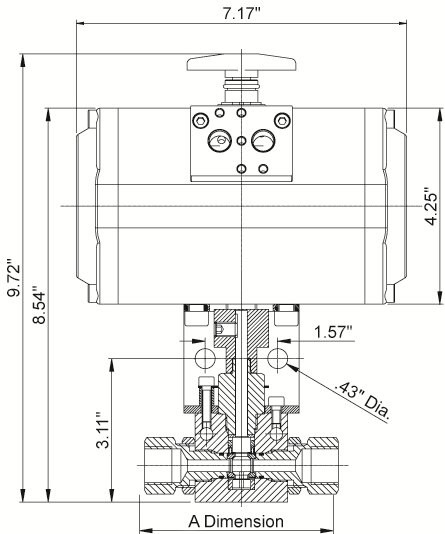Pneumatic Ball Valve Features and Pipeline Applications
Dec 13, 2023
A pneumatic ball valve is a sophisticated system composed of a ball valve and a pneumatic actuator, with the actuator classified into double-acting and single-acting types. The opening and closing actions of the ball valves are controlled through an electromagnetic valve. This valve system enables intelligent control, allowing rapid opening or closing of pipelines, effectively managing and controlling the pipeline network.

Characteristics of Pneumatic Ball Valves
Pneumatic ball valves are primarily used for isolating or connecting media in pipelines and can also be employed for fluid regulation and control. In comparison to other types of valves, pneumatic ball valves possess distinctive features:
Applications of Pneumatic Ball Valves in Pipelines
Pneumatic ball valves, as critical components in pipeline systems, find extensive and crucial applications, notably in the following areas:
Pneumatic ball valves, with their intelligent design and features like low resistance and durability, play a crucial role in fluid control. From quick cut-off to precise flow management, these valves are indispensable for optimizing fluid systems. Ongoing innovations, exemplified by V-type ball valves, highlight their adaptability in complex engineering scenarios. In essence, pneumatic ball valves are not just a fluid control solution but a cornerstone for efficiency and safety in diverse applications.

Characteristics of Pneumatic Ball Valves
Pneumatic ball valves are primarily used for isolating or connecting media in pipelines and can also be employed for fluid regulation and control. In comparison to other types of valves, pneumatic ball valves possess distinctive features:
- Low Fluid Resistance: Pneumatic ball valves exhibit the least fluid resistance among all valve types, even in the case of reduced diameter valves, where the fluid resistance remains remarkably low.
- Reduced Friction Torque with Thrust Bearings: The bearing design in the stem minimizes the friction torque, ensuring smooth and flexible long-term operation of the valve stem.
- Excellent Seat Sealing Performance: The sealing rings, made of elastic materials such as PTFE, facilitate easy sealing. Moreover, the sealing capacity of pneumatic ball valves increases with the rise in medium pressure.
- Reliable Stem Sealing: The stem performs only rotational motion without vertical movement, making the stem's packing sealing less susceptible to damage. Additionally, the sealing capacity increases with the increase in medium pressure.
- Extended Service Life: Materials like PTFE possess excellent self-lubricating properties, resulting in minimal frictional losses with the ball, contributing to a longer lifespan of pneumatic ball valves.
- Fire-resistant Design: The bottom-mounted stem and the protruding step at the stem's head prevent the stem from ejecting during a fire, ensuring the integrity of stem sealing.
- Antistatic Functionality: The inclusion of springs between the ball, stem, and valve body allows the discharge of static electricity generated during the switching process, providing antistatic functionality.
Applications of Pneumatic Ball Valves in Pipelines
Pneumatic ball valves, as critical components in pipeline systems, find extensive and crucial applications, notably in the following areas:
- Cut-off Function: Pneumatic ball valves swiftly execute a 90-degree rotation, effortlessly cutting off the flow of fluid in pipelines. This rapid cut-off capability makes them stand out in emergencies, such as pipeline leaks or urgent repairs.
- Distribution and Directional Adjustment: Through the rotational operation of pneumatic ball valves, fluid distribution to different pipelines or adjustments to the flow direction can be conveniently achieved. This flexibility makes them an ideal choice in scenarios requiring frequent adjustments to fluid paths.
- Precise Flow Control: Recent advancements in ball valve design have expanded their functionality beyond simple cut-off, allowing for precise control of medium flow. The introduction of V-type ball valves, in particular, has widened their applications in processes requiring regulation and control of fluid flow, such as in the chemical, pharmaceutical, and food processing industries.
- Corrosion Resistance and Harsh Conditions: The compact and reliable structure of pneumatic ball valves makes them suitable for applications in harsh working conditions, including environments with highly corrosive media, high temperatures, and pressures, as well as those requiring explosion-proof and antistatic features.
- Backup Safety Valve: In some systems, pneumatic ball valves serve as backup means for safety valves, enabling emergency release of media to ensure the overall safety and stability of the system.
Pneumatic ball valves, with their intelligent design and features like low resistance and durability, play a crucial role in fluid control. From quick cut-off to precise flow management, these valves are indispensable for optimizing fluid systems. Ongoing innovations, exemplified by V-type ball valves, highlight their adaptability in complex engineering scenarios. In essence, pneumatic ball valves are not just a fluid control solution but a cornerstone for efficiency and safety in diverse applications.
Next: Floating Ball Valves: Structure, Features and Safety Design
Previous: Exploring the Versatility of Slab Gate Valves
About Us
Categories
Useful Links
Our Contacts
Building 2, NO.59, Songshan Road, SND, Suzhou, China
